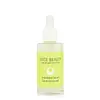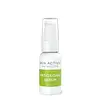What's inside
What's inside
 Key Ingredients
Key Ingredients

 Benefits
Benefits

 Concerns
Concerns

 Ingredients Side-by-side
Ingredients Side-by-side

Vitis Vinifera Juice
AntioxidantCitrus Aurantium Dulcis Juice
Skin ConditioningAloe Barbadensis Leaf Juice
Skin ConditioningGlycerin
HumectantTriethyl Citrate
MaskingGluconolactone
Skin ConditioningOenothera Biennis Oil
EmollientLinum Usitatissimum Seed Oil
PerfumingBorago Officinalis Seed Oil
EmollientVitis Vinifera Seed Oil
EmollientHelianthus Annuus Seed Oil
EmollientPullulan
Sodium Benzoate
MaskingLaminaria Ochroleuca Extract
Skin ConditioningUbiquinone
AntioxidantDimethylaminoethanol Tartrate
EmollientThioctic Acid
AntioxidantMagnesium Ascorbyl Phosphate
AntioxidantTocopherol
AntioxidantSodium Hyaluronate
HumectantSclerotium Gum
Emulsion StabilisingXanthan Gum
EmulsifyingSodium Stearoyl Glutamate
CleansingSodium Gluconate
Skin ConditioningCaprylic/Capric Triglyceride
MaskingAlcohol Denat.
AntimicrobialGluconic Acid
Sodium Hydroxide
BufferingCitrus Aurantium Bergamia Fruit Oil
MaskingCitrus Aurantium Dulcis Peel Oil
MaskingVitis Vinifera Juice, Citrus Aurantium Dulcis Juice, Aloe Barbadensis Leaf Juice, Glycerin, Triethyl Citrate, Gluconolactone, Oenothera Biennis Oil, Linum Usitatissimum Seed Oil, Borago Officinalis Seed Oil, Vitis Vinifera Seed Oil, Helianthus Annuus Seed Oil, Pullulan, Sodium Benzoate, Laminaria Ochroleuca Extract, Ubiquinone, Dimethylaminoethanol Tartrate, Thioctic Acid, Magnesium Ascorbyl Phosphate, Tocopherol, Sodium Hyaluronate, Sclerotium Gum, Xanthan Gum, Sodium Stearoyl Glutamate, Sodium Gluconate, Caprylic/Capric Triglyceride, Alcohol Denat., Gluconic Acid, Sodium Hydroxide, Citrus Aurantium Bergamia Fruit Oil, Citrus Aurantium Dulcis Peel Oil
Water
Skin ConditioningLactobacillus/Kelp Ferment Filtrate
Skin ConditioningSodium PCA
HumectantMagnesium Ascorbyl Phosphate
AntioxidantSodium Hyaluronate
HumectantFerulic Acid
AntimicrobialAloe Barbadensis Leaf Extract
EmollientCamellia Sinensis Catechins
AntioxidantNiacinamide
SmoothingCarnosine
Skin ConditioningHesperidin Methyl Chalcone
AntioxidantCarnitine
CleansingTetrahydrodiferuloylmethane
AntioxidantTetrahydrodemethoxydiferuloylmethane
AntioxidantTetrahydrobisdemethoxydiferuloylmethane
AntioxidantSorghum Bicolor Leaf/Stem Extract
Skin ConditioningLycopene
AntioxidantAstaxanthin
Skin ConditioningFucoxanthin
Skin ConditioningPorphyridium Polysaccharide
AntioxidantGlutathione
Sh-Polypeptide-2
Skin ConditioningSh-Polypeptide-77
Skin ConditioningSuperoxide Dismutase
AntioxidantCitric Acid
BufferingPropylene Glycol
HumectantDiazolidinyl Urea
PreservativeMethylparaben
PreservativePropylparaben
PreservativeWater, Lactobacillus/Kelp Ferment Filtrate, Sodium PCA, Magnesium Ascorbyl Phosphate, Sodium Hyaluronate, Ferulic Acid, Aloe Barbadensis Leaf Extract, Camellia Sinensis Catechins, Niacinamide, Carnosine, Hesperidin Methyl Chalcone, Carnitine, Tetrahydrodiferuloylmethane, Tetrahydrodemethoxydiferuloylmethane, Tetrahydrobisdemethoxydiferuloylmethane, Sorghum Bicolor Leaf/Stem Extract, Lycopene, Astaxanthin, Fucoxanthin, Porphyridium Polysaccharide, Glutathione, Sh-Polypeptide-2, Sh-Polypeptide-77, Superoxide Dismutase, Citric Acid, Propylene Glycol, Diazolidinyl Urea, Methylparaben, Propylparaben
Ingredients Explained
These ingredients are found in both products.
Ingredients higher up in an ingredient list are typically present in a larger amount.
Magnesium Ascorbyl Phosphate (MAP) is a form of Vitamin C and is an antioxidant. It can help to reduce redness, improve skin texture, reduce the effects of aging, reduce the visibility of dark spots, and brighten skin.
MAP is created by combining ascorbic acid with magnesium salt. While MAP more gentle on the skin than ascorbic acid, it is thought to be less easily-absorbed into the skin.
Due to MAP's stability up to a pH level of 7, it is more stable to air and sunlight exposure than ascorbic acid. The best pH range for MAP is between 5 and 6.
Like other forms of Vitamin C, MAP has been shown to help reduce hyperpigmentation and simulate collagen production.
As an antioxidant, it helps protect your skin against the signs of aging.
Learn more about Magnesium Ascorbyl PhosphateSodium Hyaluronate is hyaluronic acid's salt form. It is commonly derived from the sodium salt of hyaluronic acid.
Like hyaluronic acid, it is great at holding water and acts as a humectant. This makes it a great skin hydrating ingredient.
Sodium Hyaluronate is naturally occurring in our bodies and is mostly found in eye fluid and joints.
These are some other common types of Hyaluronic Acid:
Learn more about Sodium Hyaluronate